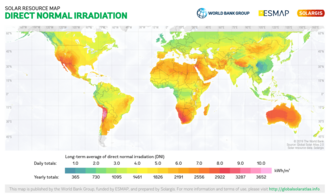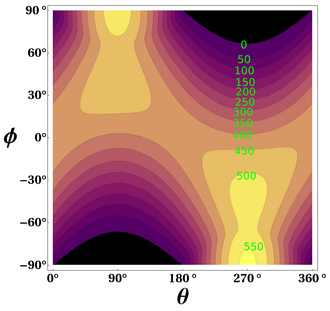
A | B | C | D | E | F | G | H | CH | I | J | K | L | M | N | O | P | Q | R | S | T | U | V | W | X | Y | Z | 0 | 1 | 2 | 3 | 4 | 5 | 6 | 7 | 8 | 9


Solar irradiance is the power per unit area (surface power density) received from the Sun in the form of electromagnetic radiation in the wavelength range of the measuring instrument. Solar irradiance is measured in watts per square metre (W/m2) in SI units.
Solar irradiance is often integrated over a given time period in order to report the radiant energy emitted into the surrounding environment (joule per square metre, J/m2) during that time period. This integrated solar irradiance is called solar irradiation, solar exposure, solar insolation, or insolation.
Irradiance may be measured in space or at the Earth's surface after atmospheric absorption and scattering. Irradiance in space is a function of distance from the Sun, the solar cycle, and cross-cycle changes.[2] Irradiance on the Earth's surface additionally depends on the tilt of the measuring surface, the height of the Sun above the horizon, and atmospheric conditions.[3] Solar irradiance affects plant metabolism and animal behavior.[4]
The study and measurement of solar irradiance have several important applications, including the prediction of energy generation from solar power plants, the heating and cooling loads of buildings, climate modeling and weather forecasting, passive daytime radiative cooling applications, and space travel.
Types


There are several measured types of solar irradiance.
- Total solar irradiance (TSI) is a measure of the solar power over all wavelengths per unit area incident on the Earth's upper atmosphere. It is measured perpendicular to the incoming sunlight.[3] The solar constant is a conventional measure of mean TSI at a distance of one astronomical unit (AU).
- Direct normal irradiance (DNI), or beam radiation, is measured at the surface of the Earth at a given location with a surface element perpendicular to the Sun direction.[6] It excludes diffuse solar radiation (radiation that is scattered or reflected by atmospheric components). Direct irradiance is equal to the extraterrestrial irradiance above the atmosphere minus the atmospheric losses due to absorption and scattering. Losses depend on time of day (length of light's path through the atmosphere depending on the solar elevation angle), cloud cover, moisture content and other contents. The irradiance above the atmosphere also varies with time of year (because the distance to the Sun varies), although this effect is generally less significant compared to the effect of losses on DNI.
- Diffuse horizontal irradiance (DHI), or diffuse sky radiation is the radiation at the Earth's surface from light scattered by the atmosphere. It is measured on a horizontal surface with radiation coming from all points in the sky excluding circumsolar radiation (radiation coming from the sun disk).[6][7] There would be almost no DHI in the absence of atmosphere.[6]
- Global horizontal irradiance (GHI) is the total irradiance from the Sun on a horizontal surface on Earth. It is the sum of direct irradiance (after accounting for the solar zenith angle of the Sun z) and diffuse horizontal irradiance:[8]
- Global tilted irradiance (GTI) is the total radiation received on a surface with defined tilt and azimuth, fixed or Sun-tracking. GTI can be measured[7] or modeled from GHI, DNI, DHI.[9][10][11] It is often a reference for photovoltaic power plants, while photovoltaic modules are mounted on the fixed or tracking constructions.
- Global normal irradiance (GNI) is the total irradiance from the Sun at the surface of Earth at a given location with a surface element perpendicular to the Sun.
Units
The SI unit of irradiance is watts per square metre (W/m2 = Wm−2). The unit of insolation often used in the solar power industry is kilowatt hours per square metre (kWh/m2).[12]
The Langley is an alternative unit of insolation. One Langley is one thermochemical calorie per square centimetre or 41,840 J/m2.[13]
Irradiation at the top of the atmosphere

The average annual solar radiation arriving at the top of the Earth's atmosphere is about 1361 W/m2. This represents the power per unit area of solar irradiance across the spherical surface surrounding the Sun with a radius equal to the distance to the Earth (1 AU). This means that the approximately circular disc of the Earth, as viewed from the Sun, receives a roughly stable 1361 W/m2 at all times. The area of this circular disc is πr2, in which r is the radius of the Earth. Because the Earth is approximately spherical, it has total area , meaning that the solar radiation arriving at the top of the atmosphere, averaged over the entire surface of the Earth, is simply divided by four to get 340 W/m2. In other words, averaged over the year and the day, the Earth's atmosphere receives 340 W/m2 from the Sun. This figure is important in radiative forcing.
Derivation
The distribution of solar radiation at the top of the atmosphere is determined by Earth's sphericity and orbital parameters. This applies to any unidirectional beam incident to a rotating sphere. Insolation is essential for numerical weather prediction and understanding seasons and climatic change. Application to ice ages is known as Milankovitch cycles.
Distribution is based on a fundamental identity from spherical trigonometry, the spherical law of cosines:
This equation can be also derived from a more general formula:[14]

The separation of Earth from the Sun can be denoted RE and the mean distance can be denoted R0, approximately 1 astronomical unit (AU). The solar constant is denoted S0. The solar flux density (insolation) onto a plane tangent to the sphere of the Earth, but above the bulk of the atmosphere (elevation 100 km or greater) is:
The average of Q over a day is the average of Q over one rotation, or the hour angle progressing from h = π to h = −π:
Let h0 be the hour angle when Q becomes positive. This could occur at sunrise when
Antropológia
Aplikované vedy
Bibliometria
Dejiny vedy
Encyklopédie
Filozofia vedy
Forenzné vedy
Humanitné vedy
Knižničná veda
Kryogenika
Kryptológia
Kulturológia
Literárna veda
Medzidisciplinárne oblasti
Metódy kvantitatívnej analýzy
Metavedy
Metodika
Text je dostupný za podmienok Creative
Commons Attribution/Share-Alike License 3.0 Unported; prípadne za ďalších
podmienok.
Podrobnejšie informácie nájdete na stránke Podmienky
použitia.
www.astronomia.sk | www.biologia.sk | www.botanika.sk | www.dejiny.sk | www.economy.sk | www.elektrotechnika.sk | www.estetika.sk | www.farmakologia.sk | www.filozofia.sk | Fyzika | www.futurologia.sk | www.genetika.sk | www.chemia.sk | www.lingvistika.sk | www.politologia.sk | www.psychologia.sk | www.sexuologia.sk | www.sociologia.sk | www.veda.sk I www.zoologia.sk








